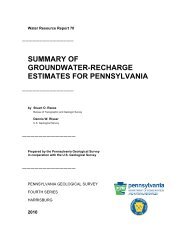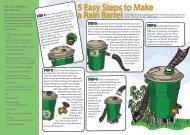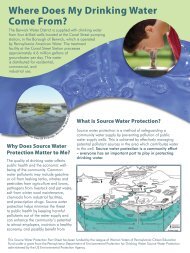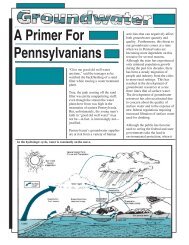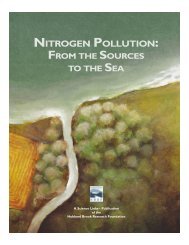Pennsylvania Noxious Weeds
Pennsylvania Noxious Weeds
Pennsylvania Noxious Weeds
- No tags were found...
You also want an ePaper? Increase the reach of your titles
YUMPU automatically turns print PDFs into web optimized ePapers that Google loves.
Please note that other control methods may exist. Formore information regarding control of the noxious weedslisted in this document contact your local NRCS FieldOffice or local Penn State Extension Office.Created by:USDA-NRCS,Lebanon Field Office2005
<strong>Pennsylvania</strong>’s <strong>Noxious</strong> Weed Control Law (selected sections)Section 4. Sale or Propagation.When a weed is declared noxious it shall be a violation of this act to sell, transport, plant, or otherwise propagate that weed within the Commonwealth, except that the secretary may permitexceptions for specific horticultural or experimental use.Section 5. Weed Control Areas.The secretary on his own motion or upon the request of any interested ested person, may hold public hearings to consider the designation of a weed control area.When a weed control area has been designated by the secretary, the tsecretary shall issue an order describing the weed control area and shall require the affected landowners to comply with this actwithin 30 days from the publication of this order. Such order may y require control measures for the noxious weed to be implemented d by landowners: Provided, however, that such order shall notimpose an unreasonable deadline for compliance or an unreasonable e financial burden on and landowner.Section 6.1. Control Order Issued Against an Individual Landowner.The secretary may issue an order requiring an individual landowner to implement control measures for noxious weeds if he finds that tnoxious weeds are growing on that landowner's property.An order issued under this section shall be in writing and shall be served on the landowner by handing a copy of the order to him m or by sending a copy of the order to the landowner by certified d mail,return receipt requested.An order may be issued under this section without a public hearing, provided that the landowner may within seven days of receipt notify the secretary in writing that he intends to contest the order. Ifthe landowner fails to contest the order within that seven-day period, it shall become final.Whenever a landowner notifies the secretary that he intends to contest can order issued under this section pursuant to subsection (c), the secretary shall provide the landowner with a hearing within wten days after receipt of notification that the order is being contested. cAfter reviewing the testimony or other evidence presented at the hearing, the secretary may affirm, modify or vacate the torder. Ifthe order is affirmed or modified, it shall become a final order under this act.(6.1 added July 7, 1994, P.L. 439, No. 72)Section 7. Compliance with Orders.An affected landowner shall comply with an order issued under section 5 within 30 days after publication. An affected landowner shall comply with an order issued under section 6.1 within 30 daysafter the order becomes final.When an affected landowner fails to comply with an order, the secretary shall notify the landowner and the municipality within which wthe landowner's property is located by certified mail. Thereafter,eafter,the appropriate officials of the municipality shall take the necessary essary steps to carry out the order within 30 days after receipt of such notification by the secretary.A municipality which acts to control or destroy a noxious weed on a noncomplying landowner's property shall have power to recover r all expenses and costs incurred in complying with the order fromthe noncomplying landowner.(7 amended July 7, 1994, P.L. 439, No. 72)Section 8. <strong>Noxious</strong> Weed Control List. (Amended November 18, 2000)The noxious weed control list shall include the following weeds:Cannabis sativa, commonly known as MarijuanaCarduus nutans, , commonly known as Musk or Nodding ThistleCirsium arvense, , commonly known as Canadian thistle Sorghum bicolor, commonly known as ShattercaneRosa multiflora, , commonly known as Multiflora rose Datura stramonium, , commonly known as JimsonweedSorghum halepense, commonly known as Johnson grassLythrum salicaria, , commonly known as Purple Loosestrife, including all cultivarsPolygonum perfoliatum, commonly known as Mile-a-minuteHeracleum mantegazzianum, , commonly known as Giant HogweedPueraria lobata, , commonly known as Kudzu-vineGalega officinalis, , commonly known as GoatsrueCirsium vulgare, , commonly known as Bull or Spear ThistleSection 10. Penalties.Any landowner who fails to comply with an order of the secretary shall be guilty of a summary offense.Any landowner who interferes with the agents of the secretary, or with a municipality and the discharge of its duties hereunder, shall be guilty of a misdemeanor of the third degree.(10 amended July 7, 1994, P.L. 439, No. 72)
MarijuanaCannabis sativaControl:Hand pull young plantsand destroy. Targetedapplications of systemicherbicides such asglyphosate may also beeffective.
Canadian thistleCirsium arvenseControl:Cut before seed sets.Repeated cutting willeventually weaken and killthe root system. Targetedapplications of systemicherbicides such asglyphosate may beeffective. Herbicideapplications are mosteffective when appliedbefore flowering.
Multiflora RoseRosa multifloraControl:Hand pull young plants. Mow or cutlarger plants repeatedly (3-6 6 timesduring growing season) to weaken andkill. Cut stumps or resprouted stumpsmay be treated with systemicherbicides such as glyphosate to killroots. Herbicide is most effective latein growing season.Multiflora can be distinguished from nativelook-alikes by the fringed bracts found atthe base of each leaf stalk and uprightstem.
JohnsongrassSorghum halepenseControl:Hand pull or mow young plants. Plow or disk larger areas ofinfestation and follow with a targeted application of systemicherbicides such as glyphosate to kill rhizomes. Foliar herbicidetreatments work best when plants are 12 to 18 inches tall andactively growing. Possible use of other herbicides will depend on othe presence of other vegetation/crops.
Mile-a-MinuteMinutePolygonum perfoliatumControl:Remove by handwearing protectiveclothing to avoidbarbs. Repeatedremoval of newgrowth throughoutthe summer isnecessary. Mowing throughout growing season will also restrictflowering. Herbicidal soaps can be used throughout the summer.Repeated applications are required.
Control:Kudzu-vinePueraria lobataComplete control requires 4 to 10 years of repeatedherbicide treatments (both broadcast and targeted)of herbicides such as Tordon K or 101, Veteran720 or glyphosate. Herbicide applications on abroad scale will affect other vegetation. Totaleradication is needed for successful control.
Bull or Spear ThistleCirsium vulgareControl:Cut before seed sets.Repeated cutting willeventually weakenand kill the rootsystem. Targetedapplications ofsystemic herbicidessuch as glyphosatemay be effective.Herbicide applicationsare most effectivewhen applied beforeflowering.
Musk or Nodding ThistleCarduus nutansControl:Cut before seed sets.Repeated cutting willeventually weakenand kill the rootsystem. Targetedapplications ofherbicides such asglyphosate may beeffective. Herbicideapplications are mosteffective whenapplied beforeflowering.
ShattercaneSorghum bicolorControl:Hand pull or mow youngplants during the first 7 to10 days of August beforeflowering. Targetedtreatments of systemicherbicides such asglyphosate work best whenplants are 12 to 18 inchestall and actively growing.Possible use of otherherbicides will depend onthe presence of othervegetation/crops.
JimsonweedDatura stramoniumControl:Hand pull young plants. Targetedapplications of systemic herbicides suchas glyphosate are effective.
Purple LoosestrifeLythrum speciesControl:Hand pullsmallinfestationsbefore seedset.Targetedapplicationsof systemicherbicides such asglyphosate (formulated forwater or upland areas) aremost effective incontrolling older plants.Herbicide applications aremost effective whenapplied late in the growingseason. Biological controlfor large infestations hasalso been approved byUSDA. For informationcontact PA Department ofAg @ 717-772772-5209.
Giant HogweedHeracleum mantegazzianumReport all sightings.Giant Hogweed Hotline:1-877-464-9333Control:Hand pulling or cutting are notrecommended in controlling this plant.Plants exude a clear watery sap whichsensitizes the skin to ultravioletradiation. This can result in severeburns, blistering and painful dermatitis.These blisters can develop intopurplish or brownish scars. Repeatedtargeted treatments of a systemicherbicides such as glyphosate are themost effective. Always wear protectiveclothing and avoid getting the sap onyour skin.
GoatsrueGalega officinalisControl:Mowing, clipping and cultivationare poor controls for this plantbecause seed is produced evenwhen plants are small. Themost effective control istreatment with selectiveherbicides such as 2,4-D.Recommend two applicationsduring the growing season fortwo consecutive years.



